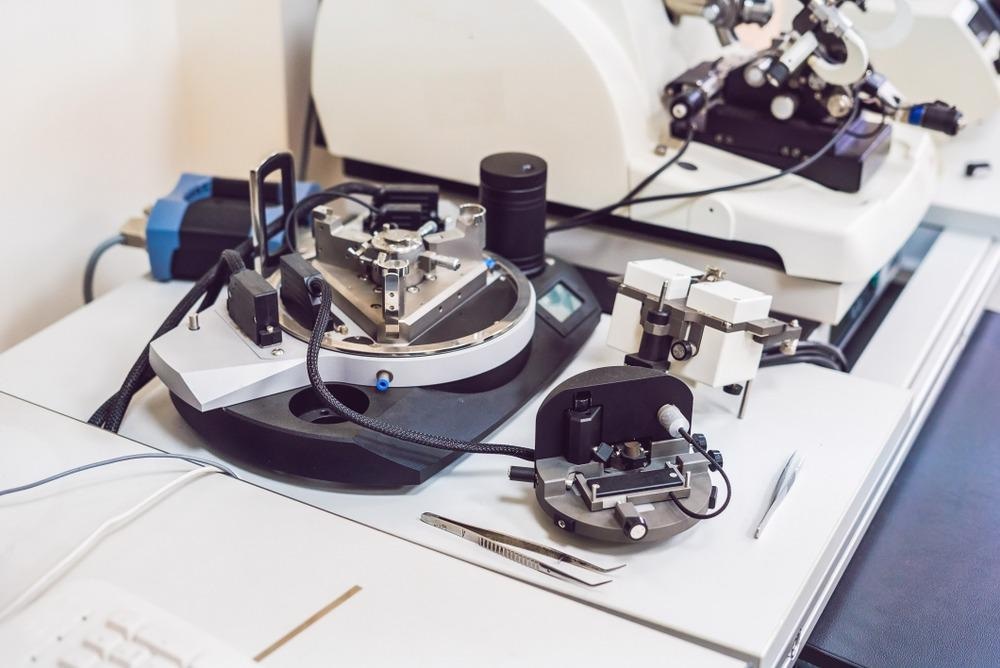Updated on 17 August 2021.

Image Credit: Elizaveta Galitckaia/Shutterstock.com
Scientists at the Beckman Institute for Advanced Science and Technology at the University of Illinois have suggested a new approach to improve AFM-IR measurements' sensitivity. This method, proposed by Rohit Bhargava and his colleagues, is based on a closed-loop feedback system using piezoelectric material and offers responsivity-corrected AFM-IR imaging.
Nanoscale materials have extensive applications in various fields, ranging from nanoelectronics and photonics to everyday devices such as sensors and batteries. To fully explore and develop their potential, the methods and tools used for their characterization must be sufficiently accurate and reliable.
Characterization of Nanoscale Materials
A very powerful tool used for the characterization of nanomaterials is the atomic force microscope (AFM). AFM is a well-established microscope used to visualize the physical structure of surfaces and materials. It has a lateral resolution of a few nanometers and a vertical resolution of about a tenth of a nanometer.
As well as its resolution, a further advantage of the AFM is that it constructs a three-dimensional image of a material's surface. However, it is challenging to obtain the chemical composition of a nanomaterial with sufficient resolution solely using AFM.
One of the most widely used methods to detect different materials' chemical composition is infrared (IR) spectroscopy. The underlying principle behind this technique is IR radiation and its interaction with matter through absorption and emission processes. Its chemical structure can be identified using the absorption and emission spectra of a material.
IR spectroscopy is a far-field technique and is more suitable when working at macroscopic scales rather than nanomaterials. However, if AFM and IR spectroscopy are combined, they can be used for atomic force microscopy-based infrared spectroscopy (AFM-IR).
This technique is rapidly emerging since it allows compositional mapping with resolution beyond the diffraction limit and chemical analysis of the sample. The underlying principle uses the tip of the AFM probe to detect thermal expansions due to the absorbed IR radiation.
Limitations of AFM-IR Spectroscopy
Alongside the advantages that AFM-IR offers, there are a few limitations to this technique. For example, since the chemical contrast depends on the sample’s mechanical composition, corrections need to be made to account for variations in cantilever responsivity. It is also essential to reduce any cantilever's vibrational noise to achieve a better signal-to-noise ratio.
To achieve sufficient sensitivity of the measurements, the substrate should also be coated with a polymer or gold, making the sample preparation more complex.
The complexity of sample preparation combined with other factors poses limitations that might narrow this approach's potential applications. Therefore, despite its simplicity, the current methods used in AFM-IR do not offer sufficient improvement to the techniques used for nanoscale materials characterization.
Piezoelectric Feedback Closed-Loop Approach
Traditionally, AFM-IR measures the cantilever deflection due to thermal expansion of the sample, induced by incident IR radiation. Although the recorded signal and the absorbed radiation are approximately proportional, probe-sample coupling occurs, and contrast that is not due to the sample's chemical composition is detected.
Rohit Bhargava and their colleagues suggested a way to overcome those limitations using a closed-loop microscopy technique. Their development indicates a way to minimize the noise and improve the instrument's sensitivity while eliminating the complex sample preparation restrictions.
This closed-loop method relies on real-time feedback control. It suggests the positioning of a piezo material underneath the substrate and applying a harmonic voltage to it so that it can be recorded and modulated. This way, the cantilever deflection voltage has an amplitude close to zero, and noise is significantly reduced.
Using this method, both the time-dependent and spatial changes in the cantilever resonance will be eliminated.
The Future of AFM-IR Techniques for Nanomaterials
This closed-loop approach minimizes the noise in the measurements and increases the technique’s chemical accuracy. It provides a promising method of achieving better quality AFM-IR measurements without the need for elaborate sample preparation and specialized substrates.
This new AFM-IR approach will be applicable for a more diverse range of nanomaterials with its improved sensitivity. It will also allow the investigation of more complex structures at different scales, such as proteins, cells, and other biological samples.
References and Further Reading
Kenkel, S., Mittal, S. and Bhargava, R., (2020) Closed-loop atomic force microscopy-infrared spectroscopic imaging for nanoscale molecular characterization. Nature Communications. https://doi.org/10.1038/s41467-020-17043-5
Dazzi, A. and Prater, C. (2016) AFM-IR: Technology and Applications in Nanoscale Infrared Spectroscopy and Chemical Imaging. Chemical Reviews. https://doi.org/10.1021/acs.chemrev.6b00448
Seth, K. et al. (2018) Probe–Sample Interaction-Independent Atomic Force Microscopy–Infrared Spectroscopy: Toward Robust Nanoscale Compositional Mapping. Analytical Chemistry. https://doi.org/10.1021/acs.analchem.8b00823
Jarman, S. (2020). Piezoelectric feedback boosts infrared atomic force microscopy [Online] PhysicsWorld. Available at: https://physicsworld.com/a/piezoelectric-feedback-boosts-infrared-atomic-force-microscopy/ (Accessed on 7 March 2021).
Disclaimer: The views expressed here are those of the author expressed in their private capacity and do not necessarily represent the views of AZoM.com Limited T/A AZoNetwork the owner and operator of this website. This disclaimer forms part of the Terms and conditions of use of this website.